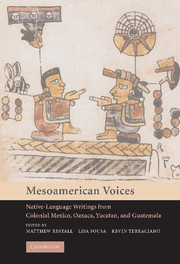2 - Literacy in Colonial Mesoamerica
Published online by Cambridge University Press: 05 October 2014
Summary
By the 1530s, Franciscan, Dominican, and Augustinian friars were beginning to teach the art of alphabetic writing to members of the indigenous elite. Between the 1540s and the end of the colonial period in the early nineteenth century, Mesoamericans produced great quantities of written records in their own languages using the Roman alphabet.
The first group to adopt the alphabet were the Nahuas of central Mexico, but they were soon followed by the Mixtecs, Yucatec Mayas, and other Mesoamericans. Nahuatl has survived in greater quantities than sources in other languages, but significant numbers of documents also have been found in Mixtec, Zapotec, Chocho, and the Mayan languages of Yucatec, Chontal, Cakchiquel, and Quiché. Otomí, Purépecha and no doubt other Mesoamerican languages also were written in colonial times. This chapter primarily discusses the nature and content of only those sources that to date have been studied in detail – those in Nahuatl, Mixtec, and Maya.
Pre-Conquest Precedents
The indigenous peoples of Mesoamerica had their own systems of written communication, ranging from the hieroglyphs of the Maya and Zapotec to the pictographs and painted codices of the Mixtec and Nahua. The earliest examples of such writing are painted or carved on stone and pottery; those from the immediate pre-Conquest period are also painted on deer hide or native paper. The texts recorded everything from histories and origin legends to divinatory and cosmological information and approached an extended narrative form of expression. Literacy was presumably a privilege of the priestly and noble classes.
- Type
- Chapter
- Information
- Mesoamerican VoicesNative Language Writings from Colonial Mexico, Yucatan, and Guatemala, pp. 11 - 20Publisher: Cambridge University PressPrint publication year: 2005



